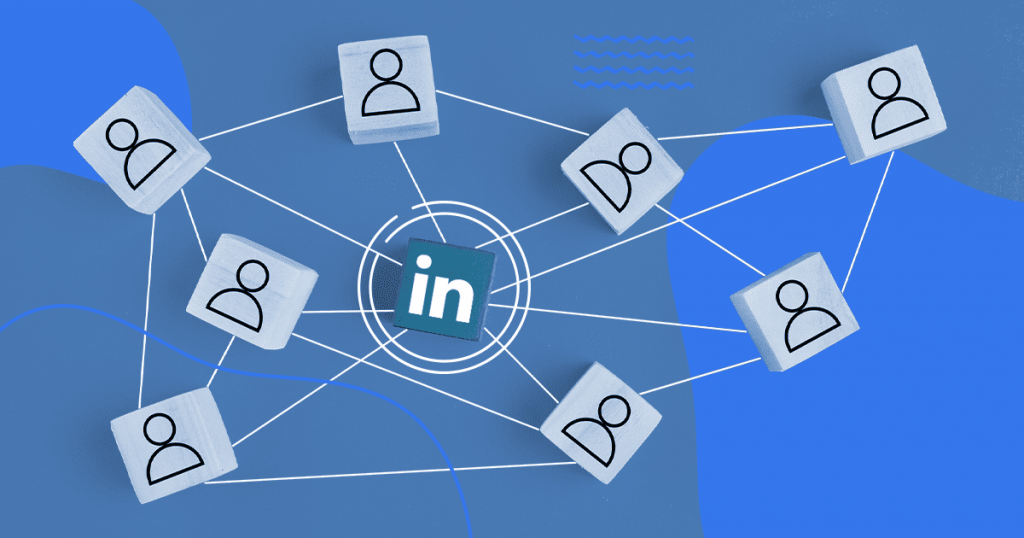Have you ever heard the saying “Who is not seen, is not remembered”?
When we think about the world of Social Media, it makes a lot of sense. Brands around the world are investing deeply in their online presences and you can’t get left behind.
Beyond Facebook and Instagram, two platforms that are already consolidated for business, there are other options with great returns that you should be considering in your strategy.
In this guide for LinkedIn, you will learn how to explore the ever-growing network and how it can be a huge opportunity for your brand.
- What is LinkedIn?
- What Kind of Features Does LinkedIn Offer?
- How Can you Create an Engaging Profile?
- How Can you Benefit from LinkedIn in your Digital Marketing Plan?
What is LinkedIn?
LinkedIn was created in 2003 before many of the most successful platforms emerged.
At that time, a group of friends realized that there wasn’t a place on the internet (which was starting to become omnipresent in our lives) focused on sharing experiences, trends, and general info about the business world.
With an initial pool of only 300 testers, they founded LinkedIn. In less than a year, it already accounted for more than 1 million users.
The social network positioned itself as a space for people all around the world to provide information about their careers and abilities so they can prosper in their professional lives.
Throughout the years, it has proven to be one of the most successful and inclusive business marketing tools.
LinkedIn Job Search, the platform’s talent hunting tool, is one of the most commonly used ways of hiring new collaborators online.
Currently, the network is used by more than 700 million people across 200 countries. The US and India report the highest number of users.
Other numbers clearly show why every company should be present on the platform and invest in exclusive strategies for it:
- Half of all Americans with college degree uses LinkedIn.
- There are 160 million users in the US, the network’s largest audience for advertising and scouting.
- a quarter of all LinkedIn users have senior-level credentials.
What this kind of data shows is that LinkedIn is a great platform for both hiring and advertising.
It is a great space for B2B, as well, and for finding specific audiences that are easier to reach than with other social channels.
What Kind of Features Does LinkedIn Offer?
With that overall setting laid out, we have enough arguments to notice how important it is to mark your presence on LinkedIn.
Find out how the platform works and the tools they have to help you stand out.
The platform isn’t that different from others like Facebook. To set up your profile you will pick a photo or image, insert a name and a description, and your company’s location.
You can also link a website and other social channels, and even share technical information about the business’ field and the number of employees.
One difference that separates LinkedIn from other platforms is the Company Pages feature made specifically for setting up a business profile for your brand.
Company Pages gives you a series of tools, reports, and data that LinkedIn provides at no extra cost.
Views, engagement, interactions with your brand, reach, info that can really help you execute your Digital Marketing plan. With it, you can analyze performance and act accordingly.
How Can you Create an Engaging Profile?
We can’t produce a LinkedIn guide without talking about how you can set up your profile with marketing goals in mind.
Knowing its main features, it is possible to optimize your pages to attract more interested leads so they can know your brand and, hopefully, become a client.
Creating Company Pages
It is really easy to set up a professional profile.
First, on LinkedIn’s home page, you have to click on “Work” located at the upper right corner. Then, scroll down to the end to find the “Create a Company Page” option.
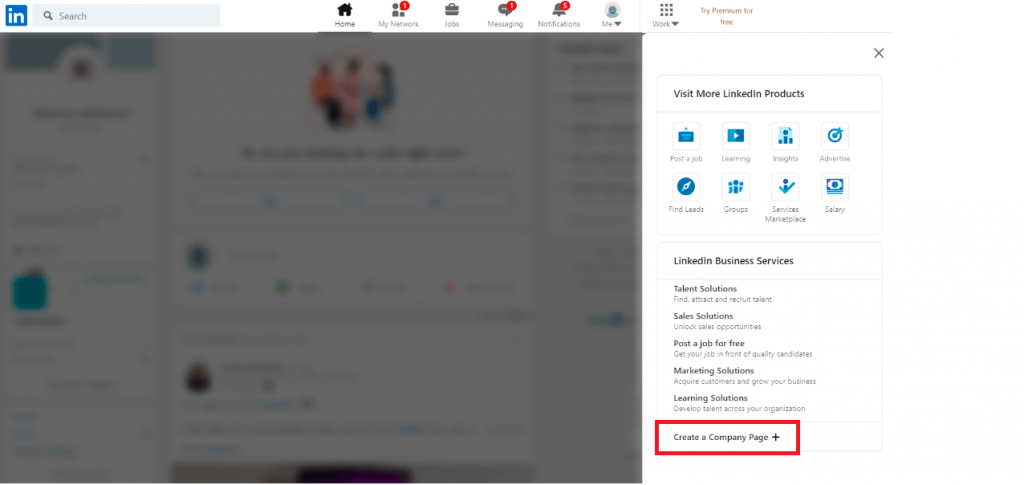
After that, you will be taken to an initial screen asking you to choose the size of your company and its nature.
Did you know that LinkedIn allows you to create pages optimized for Educational Institutions?
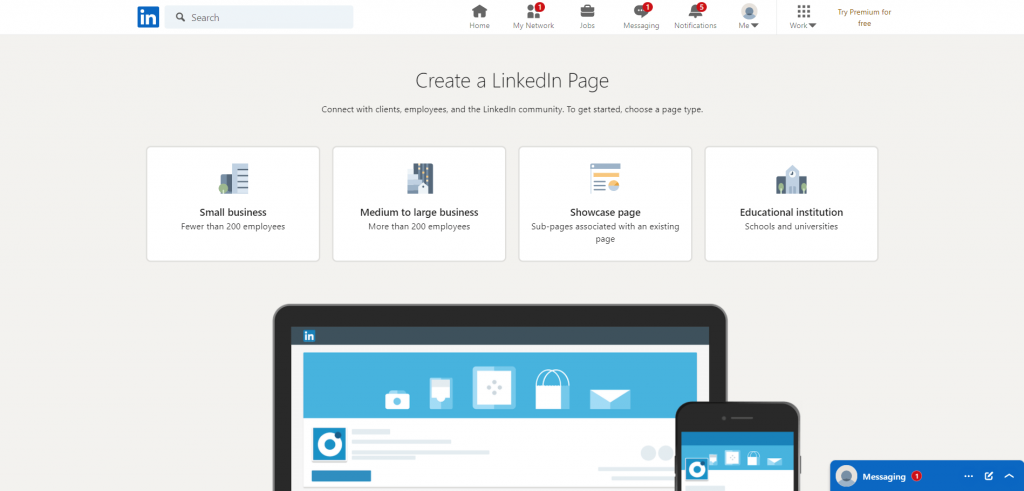
With that option selected, fill in the information that will constitute your home. Obviously, the more complete the data is, the better.
Try to imagine what your average lead would like to know first about your company. Then put in the content that will solve most of their doubts about you even before making contact.
Remember that, like any other social media, your chances of converting are greater if you let the audience know your brand well enough.
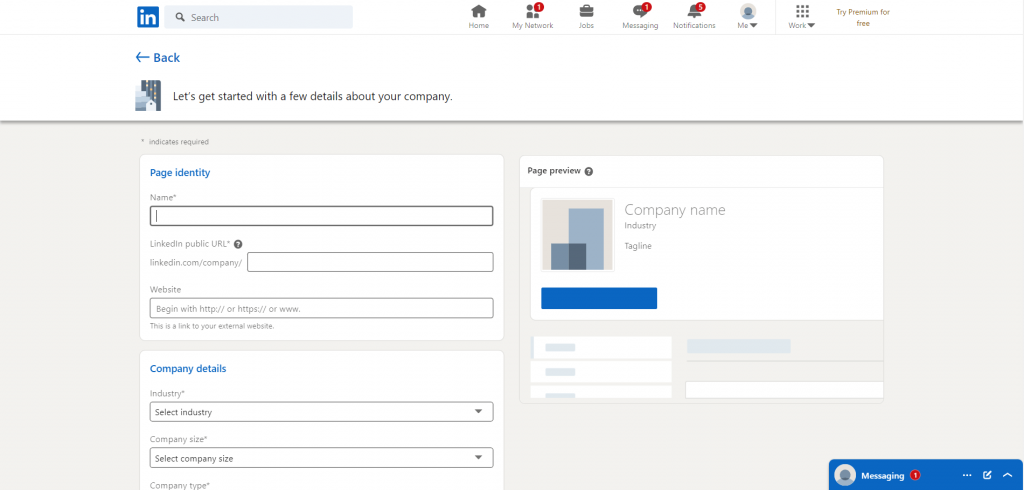
After filling in those fields, your page is ready to go.
It is time for the last revision: checking links, phone numbers, descriptions, and image quality. Any typo or badly placed photo can impact your page’s performance.
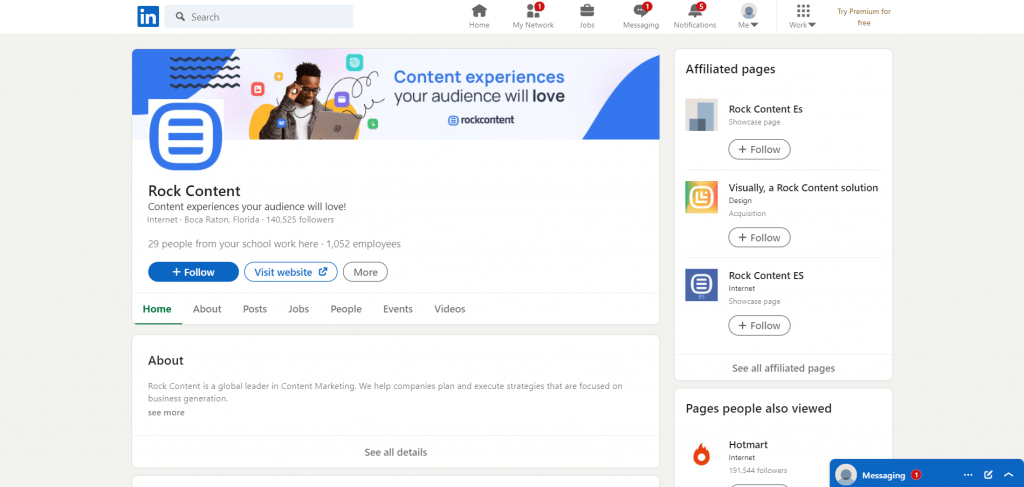
That’s it! You are now ready to start publishing content, reaching a new audience, and prospecting new clients.
Defining the right dimensions for images
LinkedIn provides different sizes and ratios for media, such as images or videos, depending on your needs for the page’s visual identity:
- Cover photo: 1128 x 191
- Company logo: 300 x 300
- Business banner: 646 x 200
- Dynamic ads: 100 x 100
- Life tab main image: 1128 x 376
- Featured images for blog posts: 1200 x 627
- Stories: 1080 x 1920
Keeping your content up-to-date
As with your plans for other social media, you have to keep a publishing schedule to have an updated profile. Timelines on those platforms are like a competition.
It means that if you don’t have consistency your brand will be lost among the noise: other companies’ posts, an update from the user’s colleague, other profiles they follow.
But frequency is nothing without quality.
Be creative to develop interesting discussions, bring relevant content, and really engage the audience in conversations.
Responding fast
One of the biggest changes in the relationship between brands and customers in recent history is how social media became one of the most used channels for Customer Service.
With the evolution of technology, these digital environments are faster, simpler, and more effective ways of contacting a company and solving doubts or issues.
Never underestimate the power an online social platform has to elevate or destroy the reputation of a brand.
Be prepared to act fast, giving quick and assertive responses to any interaction.
And do that with intent, showing real concern about your users’ difficulties and how you can help them.
How Can you Benefit from LinkedIn in your Digital Marketing Plan?
Now that you learned the main ways to use LinkedIn in your business’s favor, it is time to start elaborating better strategies, more creative and better aimed conversions.
Digital Marketing is a strong ally to brands that want to stand out and plant their flag on every social network.
Let’s see how that can be done on LinkedIn.
1. Use SEO resources
SEO isn’t useful just when ranking blogs on Google — something you probably know how to do already.
It is also a powerful tool to strengthen your brand’s visibility and reach on social networks.
A great tip on LinkedIn is to define a cluster of specific keywords for your content on that channel.
They can be used in texts, images, and post hashtags, for instance.
This way your audience can find you more easily, be more familiar with your brand, and associate it with the terms you choose.
2. Create strategic Call-to-Actions
On LinkedIn, the famous CTA — crucial to Digital Marketing plans — should be thought of as a priority on each new content.
After all, you are coming to this social network with a goal, and LinkedIn is very good for direct, efficient funnels.
Each post has to be thought of as a door to a subsequent step.
- What is your plan with that specific content?
- Take leads to your website?
- To a complementary blog post?
- To a physical address?
With those answers, think about CTAs that are creative and focused on your buyer persona.
A natural call that leaves the user curious or inspired to continue their journey throughout that subject. When used appropriately, these are great for converting.
3. Advertise your new page on other channels
Bringing several online channels together into a single strategy is crucial to create a digital unity.
In other words, show to your audience that your brand is present and active by any means.
You can create banners on your website and blog that call attention to your social media profiles. You can even do that in the physical world with press and printed content.
Online, you should produce posts in each channel that serve as pathways to the others, letting your audience know how you use them and what you offer to them as content in each case.
Spreading a unified message about your brand across multiple networks strengthens your brand by elevating mouth-to-mouth opportunities.
When a lead finds you in one place, they will probably float towards all the others in which you are present.
4. Deliver relevant content
Producing and sharing relevant content is more than advertising your brand, products, and features. It is a strategy to inform your lead on subjects that are aligned with what they expect.
Content that makes sense and it’s useful in their everyday life, not only when you are trying to close a deal, is how you retain customers.
You can do that by creating a cohesive editorial plan, with tips, trends, didactic info, and curious facts.
You can also use a more business-focused environment such as LinkedIn to tell the company’s history, what is behind the products and services you offer and share your mission and visions as a brand.
That brings your leads closer and creates a sense of identification.
The brand’s values are a priority for your brand to make connections on social media.
Converting online is a challenge but, when done right, it becomes easy and even fun to do. And, of course, it increases your chances at success.
Would you like to know more about how to have a strong brand on digital channels?
Keep studying with this special post about social media presence!
